Finding a solar-powered generator that fits your needs can be difficult. You want the best solar generator; however, every manufacturer claims that their brand is the best. With our solar generator reviews, comparison tables, and buyers guide; we will help guide you in your search. Showing you different sizes and models from various brands. Our information is independent and geared towards helping you find the best product for your needs.
Here we are showing some of the top solar generator kits, for easy assembly, so you can directly start harnessing the sun’s energy. We are presenting all the information you need to make the most educated decision. We will also explain in a few simple steps the most important features and how to set up your portable solar generator of choice.
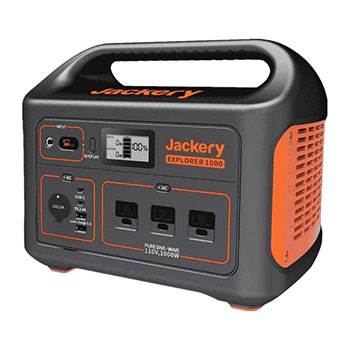
Jackery 1000
1002Wh~ Capacity
1000W Inverter
Optional 2x100W SolarSaga Solar Panels
22.04 lbs
2-Year Warranty

Bluetti AC200P
2000Wh~ Capacity
2000W Inverter
Optional 3x120W Bluetti Solar Panels
60.6 lbs
2-Year Warranty
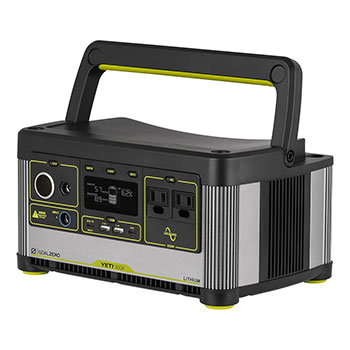
Goal Zero 500X
505Wh~ Capacity
300W Inverter
Optional 1x100W Boulder Solar Panel
12.9 lbs
2-Year Warranty
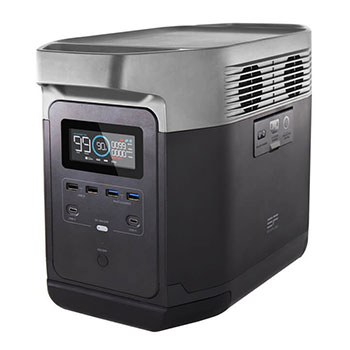
EcoFlow DELTA
1260Wh~ Capacity
1800W Inverter
Optional 3x110W EcoFlow Solar Panels
30.9 lbs
2-Year Warranty

EGO Nexus
1120Wh~ Capacity
2000W Inverter
Optional 1x180W Solar Panel
50 lbs
5-Year Warranty
In addition, we also prepared our exclusive multiple comparison tables to clearly mark the difference in each model. Comparing charging time, battery lifespan, output ports, and all the necessary features. Our unbiased, comprehensive reviews feature only the best portable solar generators on the market.
10 Best Solar-Powered Generators
1. Jackery Explorer 1000 Solar Generator

The Jackery Explorer 1000 is one of the best solar generators on the market today. It features an impressive size for the amount of power it provides. Most competitors are much larger, heavier, and pricier compared to what this solar-powered generator has to offer.
With a high capacity of 1002Wh, it meets the power supply needed to power most electrical appliances. It provides a high wattage of 1000 watt rated power and 2000 watt surge.
The Explorer 1000 has two quick-charge USB, two USB-C ports, and three AC standard outlets. Unlike most competitive models, it also has a regulated 12V DC output, which is quite desirable if you want to power any device that cannot work below 12 volts.
When it comes to recharging, it has an MPPT solar charge controller, which is better and achieves faster recharge. Most solar generators come with a PWM solar charge controller, which is less effective. Using two SolarSaga 100W solar panels refills the battery in 8 hours.
When it comes to automatic shutoff, it only shuts off after 12 hours, so if you want to power something overnight, you no longer have to worry about the unit turning off. This solar power station has an LED screen to display the standard statistics of the power output and power consumption. However, it can take up to 20 seconds to show the wattage for a device after plugging it in. Older models did not have this lag.
Another minor downside is that the 12V DC outlet and USB are combined and powered with the same button. Powering two outlets together might seem convenient, but it does waste power if you are not using both ports. It would’ve been better if the unit had two separate buttons for this.
2. Bluetti AC200P Portable Solar Generator

If you’re looking to start harnessing the sun’s power and use sustainable energy, then this is a good place to start. The Bluetti can run high-power equipment for your home, food truck, or off-grid cabin.
It is large enough to power an air conditioner, a space heater, a coffee maker, or a fridge all night long or keep most of your daily equipment charged. It comes with a capacity of 2000Wh and a 2000W pure sine wave inverter with a 4800W surge limit. This means it will be easy to run any appliance under the 2000 watt mark.
It is specially designed for high-power devices such as a circular saw or an electric drill. It’s a great solar backup power source that allows you to safely connect up to 17 devices simultaneously. It offers various ports and outlets, including wireless charging for smartphones.
It provides five recharge ways and gives you the ability to connect up to 700W of monocrystalline solar panels. You can also combine the solar power recharge with the 400W AC adapter and get it fully recharged in less than 3 hours.
The Bluetti AC200P has a certified LifePo4 battery cell with a great shelf life. It also maintains over 80% capacity after 3500+ cycles. Plus, the LCD screen is useful for showing battery input and output status. This is a powerhouse, function-packed, user-friendly, and requires no previous experience with portable solar generators.
The weight is a little over 60 pounds, which is somewhat heavy compared to other models. But it has a carrying handle on top for easy transportation. Another concern worth mentioning is the high consumption rate when it’s on standby mode. However, you can individually turn off the AC and DC output, which helps in that regard.
3. Goal Zero Yeti 500X Solar-Powered Generator

The Goal Zero Yeti 500X utilizes the latest battery management technology with advanced features. It has a superior overall design with a foldable handle and various ports.
It has a 60W USB-C PD, an 18W quick-charge USB-C, two standard USB ports, a 12V regulated DC output, and two 8mm charging ports with MPPT fast solar charging. There are also two 300W AC outputs of clean inverter sine wave energy, peaking at 1200W.
It gives you enough energy to power up more demanding devices with a battery peak capacity of 505Wh. The Yeti 500X is your electricity wall outlet in the wilderness. It is great for charging laptops, phones, tablets, and other similar sensitive electronics simultaneously. Weighing only 12.9 pounds and has a nonexistent noise level, it’s ideal for camping and indoor use.
It also has a battery management system LED screen, displaying the solar input, power output, and battery percentage. You can toggle through different units for output and view the number of hours you can power your current load for.
It has a 10.8V, 46.8Ah lithium-ion battery, and you can recharge it using three different methods. A regular wall outlet or a car charger in just 4.5 hours. Or the sun, by connecting it to a Boulder 100W monocrystalline solar panel or any compatible solar panel for a charging time of 6 to 12 hours.
One downside of the control panel is the layout of the AC outlets. In most cases, you will be able to plug in two cables next to each other. However, if you need to plug in something bulkier, it will cover up both outlets, and you will not be able to use the other one. It would be nice to have a better distribution of the outlets.
4. EcoFlow DELTA 1300 Solar Power Generator

At first glance, the EcoFlow DELTA checks all the boxes when it comes to portable solar generators. It has excellent output and input, lots of safety features, impressive build quality, and is also relatively lightweight.
One of the most significant advantages of this model compared to other brands is its recharge time. You can charge it through an AC outlet in only 1.6 hours, which is around ten times faster than any other similar specked model on the market. Additionally, it offers a fast recharge by solar panels in 4 to 8 hours.
The output is 1800 watts for all receptacles combined and 3300 watts for surge, which is quite impressive. It will power any device rated at 120V without a problem. It allows you to connect up to 11 devices simultaneously for optimum power. With a 1260Wh capacity, it’s an ideal home solar power generator setup for backup and off-grid living.
This solar generator can power a refrigerator for 7 to 10 hours. It can also power a microwave, washer, or even an air compressor for one or two hours. While also being much cheaper than competitive models, which makes it an even more desirable purchase.
The EF DELTA has a large LCD that shows you all the stats about what is happening in the device. It displays the watts in use, remaining hours, and battery charge, making it a convenient choice for a standalone solar energy system for everyday use. It also comes with a good warranty and an additional battery-specific warranty.
On the downside, the charge rate capability is temperature-dependent. If the unit gets hot, it will throttle the charge rate, and it will not allow you to discharge and recharge the unit fast.
5. EGO Power+ Nexus PST3041 Portable Power Station

The Power+ Nexus has the highest power capacity for a portable solar generator on our list. It’s perfect for powering multiple devices like the toaster, electric grill, kettle, coffee maker, blender, heater, CPAP machines, and more. It is an excellent backup solar generator for power outages at home or extended RV camping weekends to keep your essentials running.
The Nexus has four 5.0 amp-hour lithium-ion batteries and can supply 2000 watts of continuous power, maxing out at 3000 watts. The batteries are replaceable so that you can use the batteries of other EGO power tools. It has three 120 volt household outlets and four USB ports, allowing you to connect up to seven devices at the same time.
The Nexus has a huge display to help you monitor the whole status of the unit. Additionally, there is a phone app that you can download on your smartphone that allows you to pair the unit – supporting both WiFi and BlueTooth connections.
The solar generator pack weighs a little over 50 pounds, which is somewhat bulky. But that is expected due to the high power capacity. It also has sturdy construction with two handles on the side while maintaining overall good quality. It’s a highly recommended machine to anyone looking for the best solar generator of this size.
The downside is that it doesn’t offer a car port plug for 12V DC power operations. Additionally, the battery round trip efficiency is low compared to other models. The customer service is also not the best. You might have a hard time replacing or repairing a unit in case you need to.
6. Jackery Explorer 500 Solar Portable Power Station
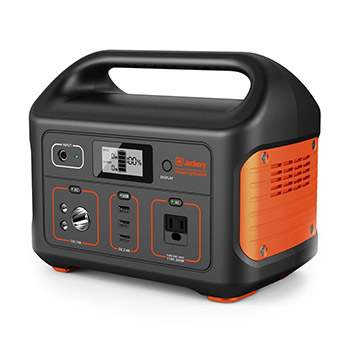
Jackery specializes in producing battery power stations and solar panels. The Explorer 500 is an overall well-made unit to have with you on your travels or during an off-road trip. Features a 24 amp-hour lithium-ion battery with a max capacity of 518 watt-hours.
It packs enough energy for light power needs. It is mostly for people who need a portable solar power system to charge their laptops, cameras, mobile devices, and other small electronic devices. The Explorer delivers 500W of pure sine wave power alongside a 1000W surge peak protection. This means you can safely power some basic appliances during short blackouts or charge your electronic devices during a power outage.
Supporting three different outputs; three USB, one AC, and one DC ports. It weighs only thirteen pounds and has a carrying handle on top. It also features a 5W efficient LED flashlight that works on different modes. Alongside an LCD that allows you to see the status of the battery at any given time.
To recharge the Explorer 500, simply connect it to the Jackery SolarSaga 100W solar panel or other compatible solar panel to get a full charge in about 10 hours. You can also charge it through a wall outlet in less than 8 hours or a DC car lighter port in less than 16 hours.
This means that once the battery is empty, it can take a long time to charge it through only the power of the sun. However, if you intend to use it only on the weekends or for a bit of camping, this solar generator setup is more than ideal for that type of usage. Boasting all the features you’d expect when purchasing a portable solar generator of this size.
7. MAXOAK Bluetti EB240 Solar-Powered Generator

The MAXOAK Bluetti EB240 has almost every major feature you could want in a large solar generator. Its 2400 watt-hours capacity gives you a long run time for powering everything you need, provided that you do not power devices over 1000W.
It allows you to connect up to 6 solar panels, which will give you up to 600W of solar power; it’s quite impressive. The unit takes about 16 hours to recharge through the AC power of a wall outlet, but purchasing a fast charger will decrease said charge time to about 5 hours. Similar to setting from solar energy, thanks to its integrated MPPT charge controller.
The battery is rated at 2500+ cycles – one of the largest solar battery capacities on the market. Other manufacturers rate their models at only 500 cycles to 80% capacity. This means, if you take care of your unit and don’t always drain the battery completely, it can easily last you anywhere between 5 to 10 years.
When it comes to output ports, it has two AC residential outlets, a regulated 12V DC port, and five USB ports. One of them being a 45W USB-C PD port, which is very useful if you have a USB-C laptop. It also has a nice digital screen that displays the battery level and the power usage in watts from all its outlets.
On the downside, it is quite heavy at 48.5 pounds, but this makes sense considering its battery size. Another negative is that it requires at least 16V to charge, so you cannot recharge it directly from your car or RV. Its large battery capacity is great, but it does ask for a larger inverter module since 1000W might be too little for powering multiple appliances in your RV.
8. Goal Zero Yeti 1500X Portable Solar Generator

Goal Zero is one of the leading brands of the best solar generators. The Yeti 1500X is a powerful addition to their lithium solar-powered batteries.
It has a 140.4Ah battery with 1516Wh capacity. Capable of running your critical appliances, including the refrigerator, freezer, microwave, TV, power tools, or home health care equipment like CPAP machines.
This portable power station is easy to use with a smart LCD display. It has almost eight versatile ports, supporting residential outlets, standard USB, USB-C, USB-PD, and 12V ports.
With a pure sine wave inverter of 2000 watts continuous and 3500 watts surge capacity, you will have a lot to work with. The energy storage system backs up four essential circuits for your home or RV. You can safely power a wide range of devices simultaneously or charge the average laptop over 31 times. It can also keep a full-size refrigerator running for over 28 hours nonstop.
The Yeti 1500X can be recharged through the Boulder 200W solar panels or other compatible panels. They can fully recharge the battery in 9 to 18 hours, depending on the sun’s visibility. You can also charge it through your AC 120W wall outlet in 14 hours or a 600W wall outlet in just 3 hours.
Moreover, there is a Yeti phone app that allows you to control and monitor your machine remotely through a WiFi connection. The software is a little awkward to use, but it is still a reliable product. The unit also lacks a dedicated Anderson input, which is standard in most solar generators. That said, the Goal Zero Yeti 1500X has a great shelf life and is very easy to use. It’s practical for many situations, whether you need a solar generator for emergencies, RVing, or outdoor events.
9. RAVPower 252.7 Solar Portable Power Station

The RAVPower 252.7 is a compact all in one solar generator with a battery capacity of 252.7 watt-hours. It’s ideal for people who need a small solar generator for powering cell phones, laptops, and similar smaller devices. It delivers 250W and a total of 300W of continuous power through two 2-prong unregulated AC outlets. There are also three USB-A ports, one with fast charging capabilities.
At about 5 pounds, it is significantly smaller and lighter than comparable models. It is also much easier to store, thanks to its rectangular design and foldable handle. It provides enough power for light uses, where you can quickly charge your electronic devices in your camper van or boat.
The battery has a life cycle of approximately 500 cycles to 80% capacity, which is pretty standard for lithium-ion batteries. When it comes to powering the unit, it features an extra 60W USB-C Power Delivery port that lets you charge it faster – in about 4.5 hours. Compared to 6 hours through solar panels or AC.
However, it only comes with a USB-C to USB-C cable and wall charger. So you will need to purchase additional cables and adapters for solar charging and charging from your car to be able to use this device to its full potential.
On the downside, the RAVPower does not have a screen. Nearly all comparable models by other manufacturers have a screen that displays power output and battery levels. Another negative is the lack of a regulated 12V DC output and a grounded 3-prong outlet, which means that you can use it to charge phones and laptops just fine, but you cannot use it with devices that require a grounded output.
10. Westinghouse iGen600s Portable Power Station
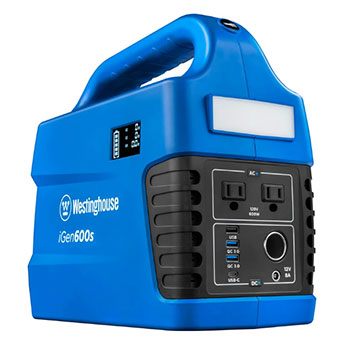
The Westinghouse iGen600s can easily power up a mini-fridge, fan, and lighting system. With as much as you would be on the move, this is an ideal camping solar generator, compact yet powerful enough to meet your power needs.
Westinghouse is a leader when it comes to power-generating tools. The iGen new solar series is designed for light outdoor adventures and emergency power needs. Capable of charging the average smartphone for over 63 times, a laptop for about 23 times, and a CPAP machine for 2 nights. Allowing you to safely power your devices with 600-watt continuous pure sine wave power inverter generator, peaking at 1200 watt.
The unit houses a 592 watt-hours battery capacity and has eight power outlets, including four USB ports and two 120V household outlets. You can power all your electronic gadgets through these ports. It’s an easy-to-use solar generator kit contained in a suitcase, set to harness the sun’s power with solar panels.
You can fully recharge the generator with solar panels in 10 hours. It can also take about 8 hours through an AC outlet, and 16.5 hours through a car outlet. It also has an LCD monitor. So it’s easy to know how much charge it has at any given time, as well as output and input levels.
While the power output may not give you a lot to work with, it is a good camping generator, suitable for tailgating parties, hunting, or fishing trips. It’s a useful option to have in your car in case of emergencies or inconveniences on the road.
The only negative aspect of the Westinghouse iGen600s is the buzzing sound that the battery unit makes when you put a high load on it. It is not particularly distracting, but it is noticeable.
Best Solar Generator Comparison Chart
| Product/Feature | Battery | Battery Life | Solar Recharge | AC Recharge | DC Recharge | Certificates |
|---|---|---|---|---|---|---|
| Jackery 1000 | 46.4Ah, 21.6V | 500+ cycles | (200W) 8 hrs | 7 hrs | 14 hrs | FCC ROHS UN38.3 |
| Bluetti AC200P | 40Ah, 58.4V | 3500+ cycles | (700W) 3-3.5 hrs | 3-5.5 hrs | 8-20 hrs | Not Available |
| Goal Zero 500X | 46.8Ah, 10.8V | 500+ cycles | (100W) 6-12 hrs | 4.5-10 hrs | 4.5 hrs | FCC ROHS CE |
| EcoFlow DELTA | 350Ah, 3.7V | 800+ cycles | (440W) 4 hrs | 1.6 hrs | 10-12 hrs | FCC ROHS CE UL PSE |
| EGO Nexus | 5.0Ah, 56V (x4) | 1000+ cycles | Not Available | Not Available | Not Available | Not Available |
| Jackery 500 | 24Ah, 21.6V | 500+ cycles | (100W) 9.5 hrs | 7.5 hrs | 16 hrs | FCC ROHS UN38.3 |
| MAXOAK EB240 | 405Ah, 3.7V | 2500+ cycles | (200W) 15 hrs | 12 hrs | 8-15 hrs | Not Available |
| Goal Zero 1500X | 140.4Ah, 10.8V | 500+ cycles | (200W) 9-18 hrs | 3-14 hrs | 14 hrs | FCC ROHS CE |
| RAVPower 252.7 | 10.6Ah, 20V | 500+ cycles | Not Available | 5 hrs | 6 hrs | Not Available |
| Westinghouse iGen600s | 160Ah, 3.7V | 500+ cycles | 8 hrs | 8 hrs | 16.5 hrs | FCC ROHS UN38.3 |
How to Choose the Best Solar-Powered Generator?
Solar generator technology is quickly and quietly becoming a mainstream way to create green energy. Green energy is cleaner and more reliable than other sources of power. They will save you money and are better for the environment, too. Not to mention, they are the best quietest generators out there, suitable for many locations. A solar power station is a machine that captures the sun’s energy using solar panels. Then converts that power into electrical power then stores it in a battery, to be released later through an inverter.
Portable power stations are commonly referred to as portable solar generators. This is a bit confusing because solar generators don’t actually generate power through burning fossil fuels like a typical portable generator. Instead, a portable power station only stores energy delivered from solar panels or household power outlets.
Deciding to buy a solar generator is an excellent choice; however, finding the best portable solar generator is a daunting task. There are many different kinds, styles, and features that it can seem like a never-ending list of devices that all look nearly the same. Throughout the rest of this article, we will list the key features available in the best solar generators. We will tell you what to avoid and give you an idea of the differences between some of the components.
If you are not sure if solar power is right for you, you can also check the difference between solar and gas generators.
Things to Consider when Choosing a Solar Generator
Some parts can make your solar generator more efficient, while others make it more costly. Choosing the right solar generator is very similar to buying a car; you have a price point in mind, you have a list of features or at least a list of uses, and you’ve done your research.
-
Type of Solar Panels
Three primary kinds of solar panels exist; monocrystalline, polycrystalline, and thin-film.

- Monocrystalline panels offer the most quality and thus are the priciest. Yielding a 15-20 percent efficiency rate and operating better in high-temp situations are the two most significant benefits of a monocrystalline solar panel.
- Polycrystalline panels come in second, carry a 13-16 percent efficiency rate, and operate slightly less efficiently in high temperatures than monocrystalline panels. The differences between monocrystalline and polycrystalline solar cells are minimal. The difference in the construction is that monocrystalline is made from a single crystal. Whereas polycrystalline solar panel is made from many crystals. Polycrystalline panels are somewhat less expensive than monocrystalline panels and are only slightly lower in quality. So they are usually the most popular choice.
- Thin-film panels are also known as amorphous crystal panels. They are usually less efficient and less convenient than their crystalline counterparts. Yielding a relatively low-efficiency rate of between 7 and 13 percent. They are constructed from a thin layer of silicon, which enables them to be more flexible and lightweight. This new technology requires a significantly more vast area of coverage to compete with mono or polycrystalline panels. But, in return, they work better in low light conditions and can handle higher temperatures better. A thin-film solar panel is, however, the cheapest option. I believe this is one of the occasions where you truly do get what you pay for as far as quality.
Choose wisely on which type of solar panel fits you best for future convenience.
-
Battery Capacity
Battery capacity is a major deciding factor when choosing a solar generator. When looking at the battery capacity of solar generators, be sure to look for watt-hours (Wh). Because that’s the right battery capacity.
For example, the average iPhone uses about 5.5Wh, and an electric blanket is about 200Wh; if your solar generator only has a 200Wh capacity, you won’t be able to charge your phone and use your blanket at the same time for more than an hour.
Some portable solar generators have battery capacities that are perfect for charging your essential devices during hunting or fishing weekends. But if you want the most powerful solar generators for home backup power during power outage situations. You’ll want something that can withstand the high wattage appliances that you have at your home. Then make sure to look for a high watt-hour battery capacity for your solar generator that can withstand your current and future power demands.
-
Inverter Rating
The inverter rating on a solar generator is a number telling you the maximum amount of watts you can pull from the generator at any given time. Depending on your desired use, you may need a solar generator with a larger inverter rating.
However, don’t be fooled; inverter size alone doesn’t influence the power capabilities of solar generators. An inverter of 1500W is useless if it’s being used with a 450Wh battery. The most effective solar generators have a ratio of 1.5:1 watt-hours/inverter rating. For example, a 1500 watt-hour battery to a 1000 watt inverter.
To sum it up, if you intend to use a solar generator to charge a couple of smartphones on a weekend camping trip. A small 200Wh solar generator will do just fine. Alternately, if you’re hoping to power your coffee machine in the event of a power outage; that size likely won’t be of much use to you.
-
Portability
Many solar generators on the market today combine functionality and practicality; allowing you to have your cake and eat it, too essentially. In any case, you’ll likely find all the features you want and need in a solar generator. Portable enough to easily transport from room to room or lift into a vehicle.
Some of the best portable generators we’ve seen weighed a decent amount but had handles and wheels; allowing for easy transportation, regardless of weight. If you want your solar generator to be as mobile as you are, then you’ll want to look for portable solar generators that are either light or have handles and wheels.
-
Extra Features
I wasn’t far off when I compared purchasing a solar generator and buying a car; there are features that you may not “need” but are especially useful to have. There are solar generators with LCD displays, making it much easier to monitor the charge of your device and the remaining battery life of your generator.
Some solar generators can wirelessly connect to apps on your phone, allowing you to monitor your solar power station and devices remotely. Also, some solar generators allow you to expand your power by connecting additional solar panels when needed.
You can also check our article about how solar power evolved into a reliable source of energy that we know today.
Things to Avoid when Choosing a Solar Generator
- Finally, avoid buying solar generators with their solar panel and battery installed in the same unit – it will shorten your battery life due to heat. Batteries hate heat.
- Avoid making an impulse decision on which solar generator to get; do your research. Solar generators with built-in solar panels are often manufactured in such a way that they cannot be repaired.
- Solar generator kits, i.e., generator battery, solar panels, cords, accessories, are more cost-efficient not only upfront but also in the long run because they can be repaired, and the individual parts can be replaced.
- Watch out for the snake-oil pitch many companies are using to convince people that their solar generators are the “best”. Avoid spending big money on low-quality solar generators.
- Purchasing the parts individually or as a kit is almost always the best choice. You get exactly the quality parts you want, and you can also replace or repair those parts as needed.
You may be interested in checking the advantages and disadvantages of solar power usage.
Setup of Solar Power Generators
How you set up your solar generator system is very dependent on which solar generator you intend to use and for what purpose. Some solar generators require little or no installation, for use when camping, driving, and backup battery use.
Meanwhile, if you’re aiming at running all the electrical equipment in your luxury RV solely on solar energy. You will have a more in-depth installation process. This includes installing the solar panels on the roof, connecting your panels to the power station, and installing the regulator. As well as, connecting your deep cycle auxiliary battery or batteries and wiring your inverter. In fact, pure sine wave inverters are a necessity if you want to run household appliances that use AC power (household); they’re what converts DC power into AC power.
Whether you’re building your solar generator power system for your home (on-grid power), or your mobile vehicle (off-grid power); then there are some things you’ll need to know.
Setup of an Off-Grid Solar Generator System
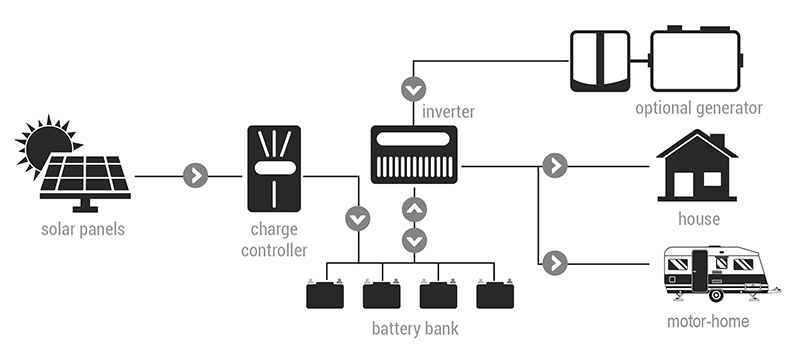
A good off-grid setup will give you the opportunity to live without a public electric utility. Whether you’re camping, traveling around the country in your RV, or just want an emergency backup power source.
Once you’ve decided how much power you will need. Having a bank of four deep-cycle batteries and two or three solar panels. You should have no problem meeting your power requirements. You also have the option of installing a whole-house solar generator system. One that is able to power an average house, complete with full-sized appliances. But that requires a pretty big budget. There are four primary things that you will need to start your off-grid solar system:
-
Solar Panels
You will need enough solar panels to efficiently charge your solar powered generators, so choosing the right ones is important. Monocrystalline panels are the most efficient (although the most expensive) choice. Polycrystalline panels are a little less efficient, but a little less expensive and can do a good job.
Pro-tip: Usually, aluminum frame solar panels are more versatile; they last longer, and they also carry a longer warranty than other flexible solar panels.
Warning: Check the warranty carefully when installing solar panels on an RV or other mobile vehicles. As this use is often not covered by warranty.
-
Charge Controller
A charge controller is a voltage regulator; designed to keep the batteries from overcharging. They are almost always a necessary component of nearly all solar-powered generators to charge batteries.
Most charge controllers will work with many high voltage solar panels. In order to regulate the maximum total input of voltage not to exceed the capacity. However, using a charge controller will cause a loss of power – from 20% to 60% of what your solar panels are rated at.
A solar panel is only capable of putting out a limited amount of amps. So although the voltage is diminished, the amperage from the solar panel cannot rise above the rated amps. Therefore, a 175W solar panel, rated at 23 volts or 7.6 amps, will only be able to put 7.6 amps at about 12 volts into the battery.
Pro-tip: Use Ohms Law (watts = volts x amps), to find out how many watts your battery is getting.
-
Battery
A high amp-hour deep cycle battery is the best choice for solar-powered generators or strictly solar recharge use. A deep-cycle battery is designed to be able to regularly deeply discharge; meaning using most of its capacity. High power usage appliances mean a shorter life per charge. So if you want to use your solar setup without worrying about every light being on or off. You will need a high amp-hour (Ah) battery. Battery options include lithium-ion batteries, which are the most expensive. Or lead-acid batteries, which are still high quality and more affordable.
-
Inverter
An inverter is a great thing to have in solar-powered generators. Because you won’t have to worry about finding a 12V charger or device while traveling. A 2000W inverter is a good choice; it will run almost anything, except an air conditioner. Additionally, it produces sine wave energy that is safe to use with sensitive electronic devices and appliances, such as mobile devices.
-
Installing of Solar Panels
Which position to set your solar panels can be a little tricky. Because you will want to generate as much power as you can during the daylight hours. When positioning your solar panels, be sure to place them facing south (if possible), and angle them at about 30 degrees. This will give you optimum efficiency throughout the year. If you live in a house that only has East and West facing rooftops. You can install solar panels on both; allowing you to get maximum coverage throughout the day.
Setup of an On-Grid Solar Generator System

An on-grid setup is very simple. You simply install a solar panel(s) on your roof or in your yard. Then connect them to a grid inverter. Then connect the inverter to your existing electrical network. This is a great way to reduce your electric bill, as well as go green using renewable energy. Allowing it to serve as a standby generator.
Pro-tip: A great option would be to install as many solar panels as you can within your budget. Then simply wire the panels into a micro-inverter, and plug the inverter into any standard 3-pin plug in your home. Power will always take the shortest route; therefore, your household appliances will use the available solar power generator before any power from the grid. However, remember that you will need an inverter or charge controller system to convert all the solar panels to household 120V/60Hz before plugging the solar arrangement into your electrical system. Additionally, for safety, this will require you to use an isolating system in case of a power outage.
Warning: Make sure to check with your building codes and permits before installation.
Bottom Line
Choosing to own a solar generator, whether for home or travel, is a great choice. Furthermore, it can and will save you money. It will also make emergency power outages, long camping trips, and cross-country RVing more comfortable, more convenient, and more fun. With so many brands and options, not to mention conflicting or absent information. It’s hard to make an educated and informed decision about a product. We brought you portable solar generator reviews and guide to make your search for the best solar generator a little easier. Whether you were trying to figure out the difference between solar panels, or you wanted to know what an inverter is. We hope we covered all the information you would need to make an informed decision.

